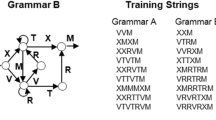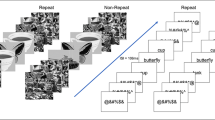Abstract
The effects of congruent and incongruent labelling on two simple cognitive tasks, sequence learning and place learning, were investigated. The results of both studies indicate the greater cognitive importance of information derived from the object compared to information derived from the verbal label.
Similar content being viewed by others
References
Davies, I.R.L. and Corbett, G.C. (1997). A cross-cultural study of colour grouping: evidence for weak linguistic relativity. British Journal of Psychology, 88, 493–517.
Deregowski, J.B. (1971). Responses mediating pictorial recognition. Journal of Social Psychology, 84, 27–33.
Deregowski, J.B. and Jahoda G. (1971). Efficacy of objects, pictures and words in a simple learning task. International Journal of Psychology, 10, 19–25.
Deregowski, J.B. and Serpell, R. (1971). Performance on a sorting task: A cross-cultural experiment. International Journal of Psychology, 4, 273–281.
Fraisse, P. (1968). Motor and verbal reaction times to words and drawings. Psychonomk Science, 12, 235–6.
Gerhand, S.J., Deregowski, J.B., and McAllister, H. (1995). Stroop phenomenon as a measure of cognitive functioning of bilingual (Gaelic/English) subjects. British Journal of Psychology, 86, 89–92.
Kearins, J. (1981). Visual spatial memory of Australian Aboriginal children of desert regions. Cognitive Psychology, 13,434–460.
Kearins, J. (1986). Visual spatial memory in Aboriginal and White Australian children. Australian Journal of Psychiatry, 38,203–214.
Klapper, Z.S. and Birch, H.G., (1969). Perceptual and action equivalence of photographs in children. Perceptual and Motor Skills, 29, 763–771.
Levinson, S.C. (1995). Language and space. Annual Review of Anthropology, 25, 353–382.
McLeod, C.M. (1991). Half a century of research on Stroop effect: An integrative review. Psychological Bulletin, 109, 163–203.
Paivio, A. (1991). Images in Mind: The Evolution of a Theory, New York: Harvester Wheatsheaf.
Paivio, A. and Csapo, K. (1971). Short-term sequential memory for pictures and words. Psychonomic Science, 24, 50–51.
Sigel, I.A. (1978). The development of pictorial comprehension. In B.S. Randhawa and W.E. Coffman (Eds), Visual Learning, Thinking, and Communication. New York: Academic Press.
Stroop, J.R. (1935). Studies of interference in serial verbal reactions. Journal of Experimental Psychology, 18, 643–662.
Author information
Authors and Affiliations
Rights and permissions
About this article
Cite this article
DerĘgowski, J.B., Parker, D.M. & Mcgeorge, P. What’s in a name, what’s in a place? The role of verbal labels in distinct cognitive tasks. Curr Psychol 18, 32–46 (1999). https://doi.org/10.1007/s12144-999-1015-1
Issue Date:
DOI: https://doi.org/10.1007/s12144-999-1015-1




